
Your New BFF
Dear Future Me…
Want to boost your mood, improve your outlook on life, pinpoint where your greatest efforts might be served, and create some accountability along the way. Imagine your future self! Picture yourself, thriving and living a full, happy life. Researchers call this your BPS-Best Possible Self and study after study say it packs a powerful punch.
Personally, I’m a big fan of this exercise. For so many of us in midlife who question what’s next and where to go from here, it’s a simple yet highly informative way to start fleshing out a new path leading the way into the second half of our lives.
Getting To Know Your Future Self
- Carve out undistracted time – find a place where you’ll have limited to no interruptions.
- Select a time in your future – anywhere between one year from now to no more than five.
- Spend a few moments visualizing your best future self, consider your –
Personal Life including your interests, hobbies, health preferences, and any accomplishments you’d like to go after. Professional Success this includes your career and job, what brings you a sense of purpose, any educational pursuits, your income bracket, and what you’d like for your retirement. Social Life your romantic or dating life, the friends you seek and keep, your relationship with your family, and any regular social activities. - Describe your future self at that time – imagine you’ve invested the time and energy to actualize your best self. What does your life look like? What are you doing personally, professionally, and socially? How do you feel? Think? Experience Life?
Note: It’s important to remember that the purpose of this exercise is not to visualize your greatest fantasy, but rather your best possible, attainable future.
From this identity you can then start to take action. Asking yourself what would my future best self do right now in this moment. This way of thinking can help you restructure your priorities and serve as a roadmap. So that when you wake up first thing in the morning and throughout your day your BPS can now be your BFF encouraging you to align with those actions that you know support your end game.
With the new year around the corner, this is a perfect exercise to take advantage of so you can hit the ground running in 2022!
Wishing You The Best Of Success
-Holly-



